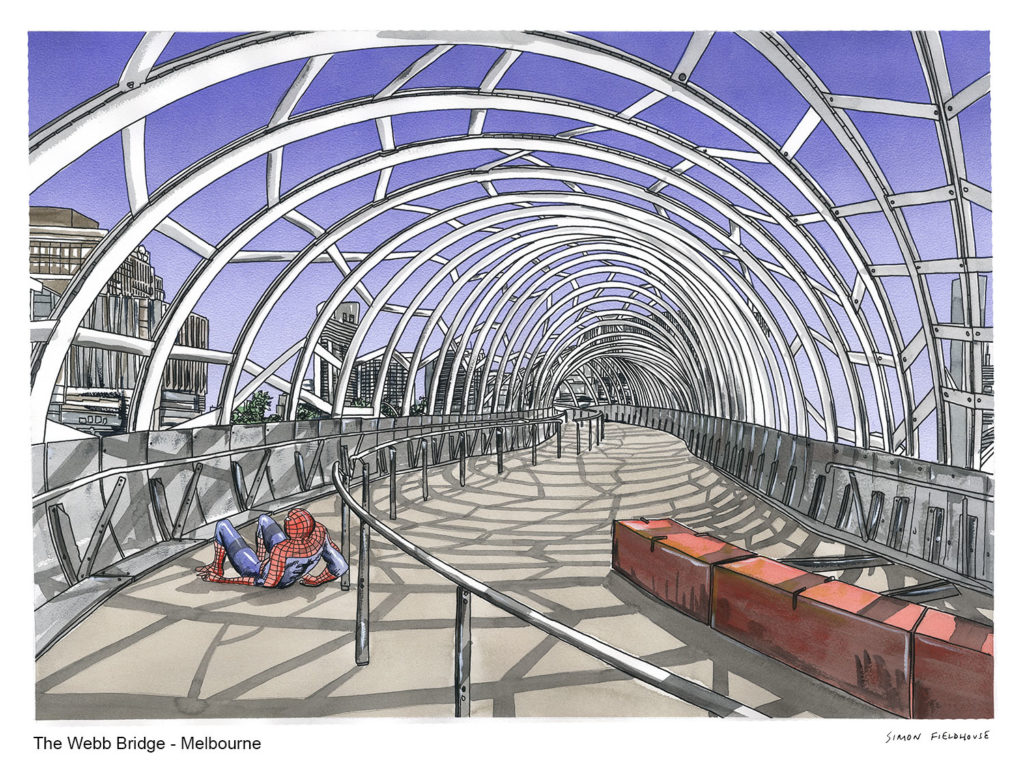
Webb Bridge - Melbourne
Webb Bridge: A Remarkable Icon of Melbourne. Webb Bridge, a stunning pedestrian and cyclist bridge in Melbourne, Australia, is a masterpiece of contemporary architecture and urban design. Located in the heart of the Docklands precinct, this bridge stands as an emblematic representation of Melbourne's commitment to innovation, sustainability, and community integration. Designed by award-winning architect Robert Owen and officially opened in 2003, Webb Bridge has become an iconic landmark in the city, admired not only for its unique design but also for its functional purpose.
One of the most striking features of Webb Bridge is its distinctive shape and structure. The bridge's curvilinear form is reminiscent of a giant, sculpted dragon, or a sea serpent emerging from the water. The bridge comprises a series of sinuous curves and arches that create a mesmerizing visual effect, especially when illuminated at night. This remarkable design was inspired by the indigenous eel traps used by the Wurundjeri people, the traditional owners of the land on which Melbourne now stands. The artistic incorporation of indigenous culture into the bridge's design is a testament to Melbourne's commitment to reconciliation and celebrating its rich cultural heritage.
Webb Bridge's unique form is further complemented by its vibrant and interactive public art installations. The bridge features a series of perforated metal panels that serve both as functional shade structures and artistic expressions. These panels are adorned with intricate patterns inspired by the natural environment and historical context of the area, creating a multisensory experience for those crossing the bridge. Furthermore, the bridge often hosts exhibitions and events, turning it into a dynamic hub for cultural activities and community engagement.
Beyond its artistic and cultural significance, Webb Bridge plays a crucial role in connecting Melbourne's Docklands with the Yarra River and the bustling Southbank precinct. It serves as a vital transportation link for pedestrians and cyclists, providing a convenient and environmentally friendly alternative to traditional vehicular transport. This sustainable mode of commuting aligns with Melbourne's broader commitment to reducing its carbon footprint and promoting a more sustainable urban lifestyle.
Webb Bridge is also a symbol of Melbourne's dedication to urban renewal and revitalization. It has breathed new life into the Docklands precinct, which was once a neglected industrial area. Today, the precinct has been transformed into a thriving community with a variety of residential, commercial, and recreational spaces, all centered around the iconic bridge.
In conclusion, Webb Bridge is a true architectural gem and a symbol of Melbourne's dedication to innovation, sustainability, cultural diversity, and urban development. Its unique design, inspired by indigenous heritage, makes it a visual delight, while its function as a pedestrian and cyclist bridge fosters sustainable transport and community connectivity. This iconic bridge showcases Melbourne's vibrant and inclusive spirit, making it an essential part of the city's identity and an attraction that continues to captivate residents and visitors alike. Webb Bridge not only bridges physical gaps but also serves as a bridge between the past and the future, uniting diverse elements of Melbourne's history and aspirations for a better tomorrow.
The most conspicuous aspect of Webb Bridge's design is its sculptural form, which draws inspiration from the indigenous eel traps used by the Wurundjeri people. The bridge's undulating curves and arches mimic the shapes of these traditional eel traps, making it a symbolic representation of the cultural heritage of the land. The decision to integrate indigenous elements into the bridge's design is not just a matter of aesthetics but also underscores Melbourne's commitment to reconciliation and acknowledgment of its historical roots.
The bridge itself is constructed primarily from steel, with its surface adorned by thousands of laser-cut perforated metal panels. These panels serve a dual purpose – they provide shade and shelter to pedestrians and cyclists while simultaneously creating a unique visual display. These intricate metal panels, featuring patterns inspired by the surrounding natural environment and indigenous culture, filter sunlight, casting fascinating patterns of light and shadow across the pathway, transforming the bridge into an ever-changing art piece. This play of light and shadow creates a sensory experience that evolves throughout the day and is particularly enchanting at night when the bridge is lit up.
Webb Bridge's functionality is just as impressive as its artistic expression. It serves as a vital transportation link connecting the Docklands precinct with the Yarra River and Southbank, providing an accessible and eco-friendly route for pedestrians and cyclists. The bridge's gently sloping pathway ensures a smooth and inclusive experience for all users, including those with disabilities.
The bridge's design also pays careful attention to environmental sustainability. It incorporates rainwater harvesting systems, with water being collected and used to irrigate nearby gardens. This eco-friendly approach aligns with Melbourne's broader commitment to environmental responsibility and sustainable urban development.
Moreover, the use of materials like steel and perforated metal panels ensures that the bridge is not only aesthetically pleasing but also durable and relatively low maintenance, contributing to its longevity and resilience in the face of Melbourne's varying weather conditions.
In conclusion, Webb Bridge's architectural and design elements are a harmonious fusion of indigenous inspiration, artistic innovation, and functional utility. Its sculptural form, intricate metal panels, and commitment to sustainability make it a model of contemporary urban design that elevates its surroundings and serves as a testament to Melbourne's creative spirit. Webb Bridge is not merely a means of crossing a river; it is a work of art that brings people together, celebrates cultural diversity, and connects the past with the future in a visually captivating and functional manner.